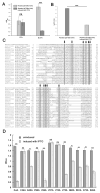Isolation and Characterization of a Novel Virulent Phage ASG01 of Aeromonas salmonicida and Its Cell Wall Hydrolase Activity
- PMID: 38543679
- PMCID: PMC10975977
- DOI: 10.3390/microorganisms12030629
Isolation and Characterization of a Novel Virulent Phage ASG01 of Aeromonas salmonicida and Its Cell Wall Hydrolase Activity
Abstract
Aeromonas salmonicida is an important pathogen that causes furunculosis in trout and salmon with high morbidity and mortality, resulting in significant economic losses in aquaculture. Overuse of antibiotics has led to the continuous emergence of drug-resistant strains. Hence, there is an urgent need to find an alternative environmentally friendly antimicrobial agent. In this study, we isolated a virulent phage of A. salmonicida, named ASG01, which belongs to the Myoviridae family and maintains lytic activity at a pH value range from 4 to 12 and in the temperature range from 30 °C to 60 °C. The whole genomic sequence of ASG01 showed 82% similarity to Aeromonas phage pAh6-C. The cell wall hydrolase (Cwh)-encoding gene from the genome of ASG01 was predicted and heterologously expressed. Notably, in the absence of additional phage genes, endogenous expression of Cwh could lyse E. coli cells and greatly inhibit the growth of tested fish pathogenic bacteria. The lytic activity of Cwh was eliminated when the predicted active site was mutated. These results indicate that Cwh of ASG01 possessed excellent lytic activity and a wide antibacterial spectrum, suggesting its potential as an effective enzybiotic.
Keywords: antibacterial agent; aquaculture; endolysin; heterologous expression; site-directed mutation.
Conflict of interest statement
The authors declare no conflicts of interest.
Figures





Similar articles
-
Isolation of a Virulent Aeromonas salmonicida subsp. masoucida Bacteriophage and Its Application in Phage Therapy in Turbot (Scophthalmus maximus).Appl Environ Microbiol. 2021 Oct 14;87(21):e0146821. doi: 10.1128/AEM.01468-21. Epub 2021 Aug 18. Appl Environ Microbiol. 2021. PMID: 34406829 Free PMC article.
-
Isolation, Characterization and Genomic Analysis of a Novel Jumbo Phage, AerS_266, That Infects Aeromonas salmonicida.Microorganisms. 2023 Oct 28;11(11):2649. doi: 10.3390/microorganisms11112649. Microorganisms. 2023. PMID: 38004661 Free PMC article.
-
Characterization and protective effects of lytic bacteriophage pAh6.2TG against a pathogenic multidrug-resistant Aeromonas hydrophila in Nile tilapia (Oreochromis niloticus).Transbound Emerg Dis. 2022 Jul;69(4):e435-e450. doi: 10.1111/tbed.14321. Epub 2021 Sep 25. Transbound Emerg Dis. 2022. PMID: 34514728
-
Recent Insights into Aeromonas salmonicida and Its Bacteriophages in Aquaculture: A Comprehensive Review.J Microbiol Biotechnol. 2020 Oct 28;30(10):1443-1457. doi: 10.4014/jmb.2005.05040. J Microbiol Biotechnol. 2020. PMID: 32807762 Free PMC article. Review.
-
Virulence, genomic features, and plasticity of Aeromonas salmonicida subsp. salmonicida, the causative agent of fish furunculosis.Vet Microbiol. 2014 Feb 21;169(1-2):1-7. doi: 10.1016/j.vetmic.2013.06.025. Epub 2013 Jul 9. Vet Microbiol. 2014. PMID: 23890675 Review.
Cited by
-
Characterization and genomic analysis of two Aeromonas phages.Front Microbiol. 2025 Jun 9;16:1585026. doi: 10.3389/fmicb.2025.1585026. eCollection 2025. Front Microbiol. 2025. PMID: 40552054 Free PMC article.
References
-
- Imbeault S., Parent S., Lagacé M., Uhland C.F., Blais J. Using bacteriophages to prevent furunculosis caused by Aeromonas salmonicida in farmed brook trout. J. Aquat. Anim. Health. 2006;18:203–214. doi: 10.1577/H06-019.1. - DOI
LinkOut - more resources
Full Text Sources

